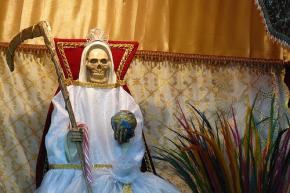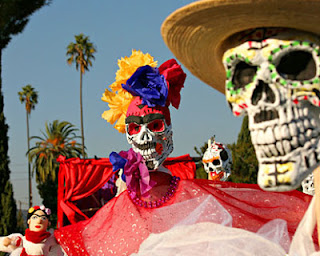El Dia de los Muertos (the
Day of the Dead), is a popular Mexican day of remembrance, which is a day to
celebrate those that have passed on. To remember
those departed the observers usually fix special foods, decorate graves and
tombs with colorful papel picado , bring flowers to the dead, leave them
candy, too and use a lot skeletons and skulls to denote the day, and in some
areas they have festive parades. Most of
those that follow this tradition believe that the ghosts of their deceased
loved ones visit their families on October 31 and
leave on November 2.
In
order to commemorate the day, families make altars and place their offerings of favorite foods,
including the sweet bread called, Bread for the Dead, (pan de muertos), which is often formed in the shapes of
skulls, on these altars or at the grave site.
They also use figures of death, candles, incense, yellow marigolds known
as cempazuchitl and most meaningfully,a photo of the departed individual is placed on the
altar, along with a ‘photo,’ of Jesus.
It
might appear to be gruesome, but many Mexicans answer death with mourning and
with delight and pleasure. They glare at
death with the same apprehension as any other society, however there is a
distinction. They expose their fright by
disdainful and existing alongside mortality even if only for a few days each
year. Death is evident in everyday life.
It is in art, stories and even in
children's toys. Children often play
funeral with toys that correspond to coffins and undertakers.
In Mexico, you might hear someone say, "La muerte es
flaca y no puede conmigo." Which means, "Death is weak and she
can't take me." Sadly, this is a
funny derision toward death, but she will get us all, sooner or later.
"All the days ordained for me
were written in Your book
before one of them came to be." Psalm 139:16
were written in Your book
before one of them came to be." Psalm 139:16



No comments:
Post a Comment